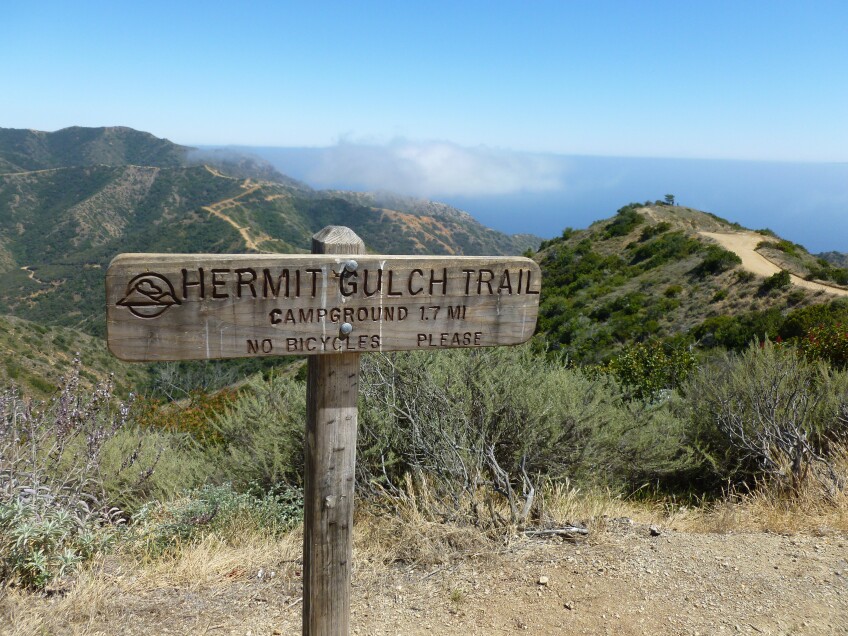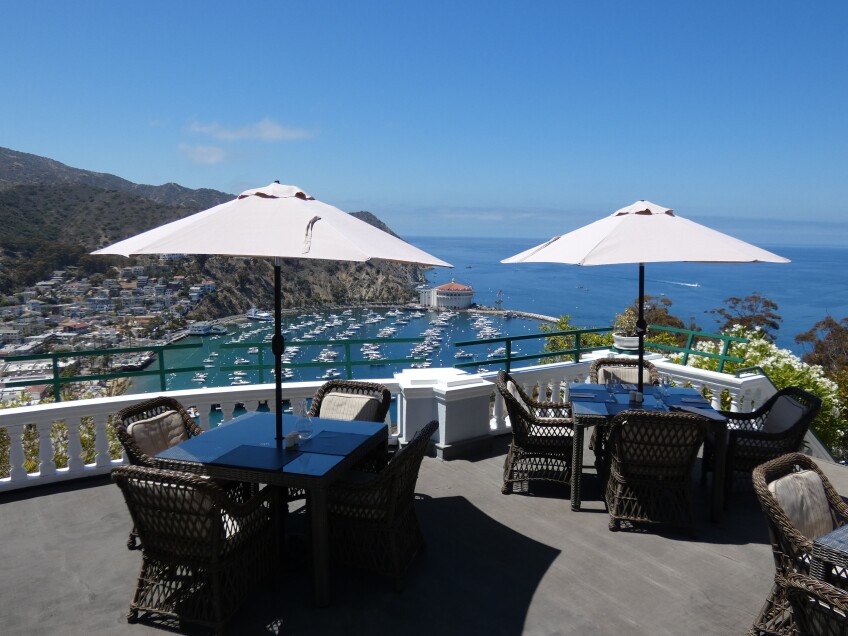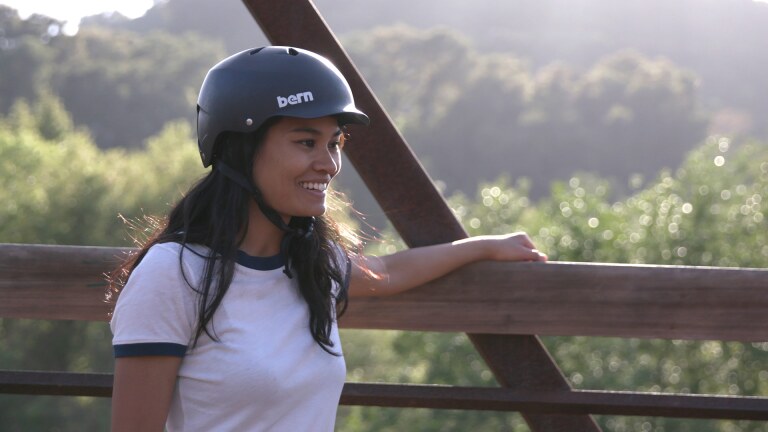Seven Best Places to Visit in and Around Avalon on Catalina Island

Santa Catalina Island — located 22 miles off the coast of the Los Angeles/Long Beach harbor areas — was formed the same way the rest of the archipelago known as the Channel Islands were.
Tens of millions of years ago, tectonic plates went crashing into one another, forming a mountainous outcropping off the shore of Southern California in the Pacific Ocean.
But unlike the islands of Channel Islands National Park — Anacapa, San Miguel, Santa Barbara, Santa Cruz and Santa Rosa — part of Catalina’s 75 square miles was developed in the 1920s as a tourist destination replete with hotels, restaurants, shops and other developments (including infrastructure and even a short-lived tile industry).
The center of it all, the town of Avalon, drew visitors with its miles of uninterrupted shoreline, abundant marine life, water sports and dazzling nightlife — much of which can still be enjoyed today in much the same way it was a century ago (with some high-tech improvements).
A visit to Avalon is less about "roughing it" and more about escaping to a nearby island that feels like it’s a world away — with lots of vintage charm crammed into a town so tiny and walkable, cars are practically non-existent there!
If you’ve been putting off a visit to Catalina, now is the perfect time to grab some layers (it’s cooler but more humid there than on the mainland) and hop across the Gulf of Santa Catalina.
Here are seven places you can spend your island time in Avalon — and just beyond — whether you’ve got just the day, a weekend or an entire week!
1. Catalina Casino
One of the most iconic images of Catalina Island and its harbor in the town of Avalon is of "the Casino building." You can see it from high up in the undeveloped interior — and from the sea, as you arrive via boat. In fact, no matter where you are on — or near — the island, you're aware of it. And while the island is full of many ornamentations (like Catalina Tile), monuments and recreation to attract visitors from the mainland, there's no other gathering place quite like this one.

Contrary to our modern interpretation of its name, the Catalina Casino wasn't dedicated as a gambling hall (though gambling has occurred in the past on the island and in its harbor). Instead, people would simply socialize there amidst music and movies.


Built in 1929 at the behest of William Wrigley, Jr. — who owned Catalina and developed Avalon as a tourist attraction — the casino looks a bit like a baseball stadium (though that’s not where the Wrigley-owned Chicago Cubs trained while on the island). But as soon as you get to the casino’s "undersea fantasy" forecourt with its resident mermaid, you realize you're there for anything but an afternoon ballgame.
To experience the Casino for yourself, one option is to take a guided tour offered by the Catalina Island Company. Your docent will take you into the Avalon Theatre — the first theatre built with acoustics specifically designed for the projection of "talkie" movies, now only open for special events like the annual Catalina Film Festival — as well as the world’s largest circular ballroom, where the Art Deco Society of Los Angeles hosts its annual Avalon Ball.

The Casino is also the future site of Catalina Divers Supply, which will take over the former home of the Catalina Island Museum — in addition to its current location on the Green Pleasure Pier. This will put divers and snorkelers just a stone’s throw away from the offshore dive area developed and designed by Catalina Divers Supply in 1962, the Marine Protected Area known as Casino Point Dive Park.
2. Wrigley Memorial and Botanic Garden

Chewing gum magnate William Wrigley Jr. did most of his candy business out of Chicago — but he liked Southern California so much, he bought the island of Catalina in 1911 and spent his summers in Avalon. When he died in 1932 at his Phoenix home, his final resting place was to be on Catalina Island.
It took around three months' worth of excavation to make way for the 232-feet-wide and 180-feet-deep hillside monolith that now stands as a memorial to Wrigley, though it wasn’t competed until 1934. The Wrigley Memorial has only been open to the public since 1947 when Wrigley’s remains were relocated to the Sanctuary of Gratitude at Forest Lawn Memorial Park in Glendale.
After that, the botanical garden that Pasadena horticulturalist Albert Conrad first planted in 1935 expanded to nearly 40 acres. It now also includes native and endemic species like the Catalina ironwood (Lyonothamnus floribundus ssp. floribundus), Catalina manzanita (Arctostaphylos catalinae) and Catalina mahogany (Cercocarpus traskiae). You can also still see remains of Conrad’s original Desert Plant Collection.
The garden entrance is 1.5 miles up Avalon Canyon Road from town, reachable on foot, by bike or golf cart or via the Garibaldi Shuttle bus. Purchase your admission onsite or check in with your advance ticket purchase and walk through the garden to reach the bottom of the circular stairway of the Memorial. From there, it's another 130 feet to the top of the 80-foot tower.

On your way up, admire the locally-sourced building materials — including decorative tiles, aggregate rock that had been quarried and crushed on the island at Pebbly Beach Quarry and blue flagstone quarried from the back of Catalina Island at Little Harbor. Both the red terracotta roof tiles and the handmade glazed tiles (including those in the fountain) came straight from the Catalina tile plant that Wrigley himself had established on the island. And although Wrigley himself is no longer in there, the original grave memorial marker is.
3. Hermit Gulch Campground and Trans Catalina Trailhead
Along Avalon Canyon Road, heading inland from town towards the Wrigley Memorial, you’ll hit the only campground within Avalon city limits — Hermit Gulch, situated in Avalon Canyon. In addition to 40 tent sites, there are also tent cabins that can accommodate three to six people each — all with access to restrooms and coin-op showers by advance reservation only. For a list of campground rules, click here.

Hermit Gulch Campground isn’t just close to all the town of Avalon has to offer — it also provides access to some of the best hiking on the island. From the campground, you can reach the trailhead for the Trans Catalina Trail, which traverses the entire island across nearly 40 miles of its "backbone."
If that feels a little too ambitious for you, another option is to trek 1.6 miles up a steep, single-track trail (gaining about 1200 feet in elevation) to reach the Hermit Gulch Lookout, with its 360-degree views of the ocean and the island’s wild interior — keeping your eyes open for the endemic Catalina Island fox.
Then, return the way you came, or make a loop by descending the fire road (a.k.a. Divide Road) until it reaches Avalon Canyon Road — which will take you down past the Wrigley Memorial, through the Botanic Garden and back to the Hermit Gulch Campground.
You’ll need a free permit to hike any of the island’s trails, which are managed by Catalina Island Conservancy. Check the organization’s website for hiking tips, policies and cautions — including its bison safety sheet.
4. Descanso Canyon
As you head away from Avalon’s town center along St. Catherine Way, just beyond the Catalina Casino is Descanso Beach and the former site of the Hotel St. Catherine — now home to Descanso Beach Club, where you can reserve a chaise lounge chair or cabana and drink on the beach.
But as you proceed farther inland, behind the resort, you’ll find entertainment of a more ecological variety — including a rock climbing wall, the Catalina Falconry Experience, Catalina Aerial Adventure at Descanso Canyon Adventures Center and the Catalina Zip Line Eco Tour at the Zipline Tour Center.

During the two-hour guided zipline excursion, guides provide thorough instruction before suiting you up — and beginners will be relieved to know that they’ll start you off on a bunny slope before the runs get increasingly longer and more exhilarating. Gaze out upon the boat-flecked ocean shore as you slice through the treetops, dangling from a wire, tethered by straps and carabiners.
It's an adrenaline-packed way to witness and learn about Catalina's ecologically diverse (and wild!) interior without having to do any hiking — and you can even zip at night there during the summer. Combo packages with transportation provided by Catalina Express from San Pedro, Long Beach or Dana Point are available.
5. Lover’s Cove
Catalina Island may offer more than 60 miles of coastline — but among its most popular beaches and secluded coves is Lover’s Cove, located between Avalon Bay and Pebbly Beach. The rocky shore off Pebbly Beach Road near the rock formation known as Abalone Point leads you to the Lovers Cove State Marine Conservation Area, a protected ocean habitat without boat moorings and where sportfishing is prohibited. From the shore, you can enter the water for some of the best snorkeling you’ll find in Southern California — with fish species like the garibaldi (Hypsypops rubicundus, California’s state saltwater fish) easily visible as they mingle amidst the giant kelp.
You can rent snorkel gear from several outfitters in Avalon — including Wet Spot Rentals, which is just steps away at the Boat Landing at Cabrillo Mole. Bring a bag of frozen peas to make fast friends with the fish and create a feeding frenzy at eye level. Diving Catalina also offers guided snorkeling tours of Lover’s Cove complete with equipment rentals and a lesson for beginners.

If you’d rather stay dry while getting up close and personal with the inhabitants of Catalina’s underwater gardens, climb aboard the Moonstone — a glass bottom boat that takes you on a 40-minute voyage into Lover’s Cove to watch garibaldi, calico bass (Paralabrax clathratus), opaleye (Girella nigricans) and more as they swim right below the boat’s hull. It’s a continuation of a 100-year tradition — which started out when fishermen replaced the bottoms of their boats with glass to improve their hauls. Tourists took notice and asked the fishermen to take them out — and it’s been a popular activity ever since.
Yet another ocean tour of Lover’s Cove — the Undersea Sub Expedition aboard the Sea Wolf Semi-Submersible — positions passengers five feet below the ocean surface to sit eye-to-eye with entire schools of fish. From this vantage point, you get to see the orange garibaldi shimmering as the sunlight hits the water — and some of the other fish will even curiously approach the porthole windows to say hello too. Tickets for both the glass bottom boat tour and the Undersea Sub Expedition are available from the Catalina Island Company, either online or at its booth on the Green Pleasure Pier.

6. Bison Backcountry
If you’re interested in spotting some of Catalina’s most famous inhabitants — its herd of bison — you’ll need to leave Avalon and, more than likely, head into the backcountry where no vehicles or golf carts are allowed. Well, none except the open-air biofuel Hummers and other tour vehicles operated by Catalina Island Company for their land tours.
Two options for tackling the island outback are the Ridgetop Eco Adventure — which travels through the “east end” of Catalina Island, crossing the Trans Catalina Trail and passing hikers hoofing it along Divide Road — and the Bison Expedition, which goes a little farther afield in search of the national mammal of the U.S. (designated in 2016).
Both excursions descend the 19th century-era Stagecoach Road, built for horse-drawn wagons that would take early tourists down to Avalon at breakneck speed. As you round the bend of Wishbone Loop — built for those wagons that couldn't make a hairpin turn — you’ll be on the fast track back to civilization.
7. Mt. Ada
You’ve got plenty of options of places to stay on Catalina — from campgrounds to historic inns — but none offer quite the same experience as Mt. Ada, built in 1921 as the Avalon “summer cottage” for William Wrigley, Jr. and his wife Ada.
The Georgian Colonial Revival style mansion — a national landmark designed by Chicago architect Zachary Taylor Davis — is situated on the top of a hill overlooking what used to be the spring training field that Wrigley built for his Chicago Cubs, appropriately named "Wrigley Field." Today, you can enjoy that same perspective from the wrap-around terrace as it’s been operating as a hotel since 1985.


Overnight guests have full access to William’s former billiards room and Ada’s former mahjong room, where they’ll find a few period-appropriate artifacts and even a couple of pieces of original furniture. Room choices include William’s former suite (the “Grand Suite”), Ada’s former suite (the "Queen’s Aviary") and the guest room that hosted extra-special guests like the Prince of Wales (the "Windsor Room").
Among other amenities, Mt. Ada guests also have access to their own golf cart during their stay in one of the six en suite guest rooms on the second floor. Breakfast and lunch are currently provided to guests only, but lunch reservations for non-guests have been available in the past and may be offered again at some point in the future. Visitors who aren't staying at Mt. Ada can see it from Wrigley Road at the Buena Vista Point Scenic Overlook.
How to Get to Catalina Island:
Unless you’re sailing to Catalina Island on a privately owned vessel, you’ll need to take public transportation from the mainland. The ferry service with the most flexibility is Catalina Express, which departs from three different Southern California ports: San Pedro (at Berth 95, the Catalina Sea and Air Terminal), Long Beach (at Golden Shore) and Dana Point (at Dana Wharf Sportfishingin Dana Point Harbor). Overnight parking is available at each port departure point for a fee.
Catalina Express’s fleet comprises eight high-speed, high-tech vessels, including four high-speed catamarans: the Starship Express, Catalina Jet, Cat Express and the Jet Cat Express. With your choice of up to 30 daily departures, you can get to Catalina Island — either via Avalon or Two Harbors — in as little as an hour to 90 minutes.
Because of COVID-19 restrictions, at this time there is currently no food or beverage service on the Catalina Express ferries. In accordance with federal regulations for public transportation, masks must be worn at all times — inside the ferry or on its outside deck. If you’d like to sit outdoors on the deck, it’s recommended that you arrive at the terminal and line up as early as you can so you’re close to the front of the line.
For those escaping to Catalina from Orange County, another option is the Catalina Flyer with daily departures from Newport Beach (next to the Balboa Pavilion in Balboa Village, Newport Harbor) at 9 a.m. and return trips from the island to the mainland at 4:30 p.m. This three-deck ferry is currently operating at a reduced passenger capacity for COVID-19 and also requires face coverings to be worn at all times.
And the quickest way to get to Catalina? By air! You can book helicopter service from San Pedro, Long Beach (at the Queen Mary Heliport) and even Burbank via IEX Helicopters, which will drop you off at the Pebbly Beach Heliport in Avalon. The one-way journey takes just 15 minutes.
Or, you can fly a private plane directly into Catalina’s only airport — its “Airport In the Sky,” which originally opened in 1946 and is currently owned and operated by the Catalina Island Conservancy.




